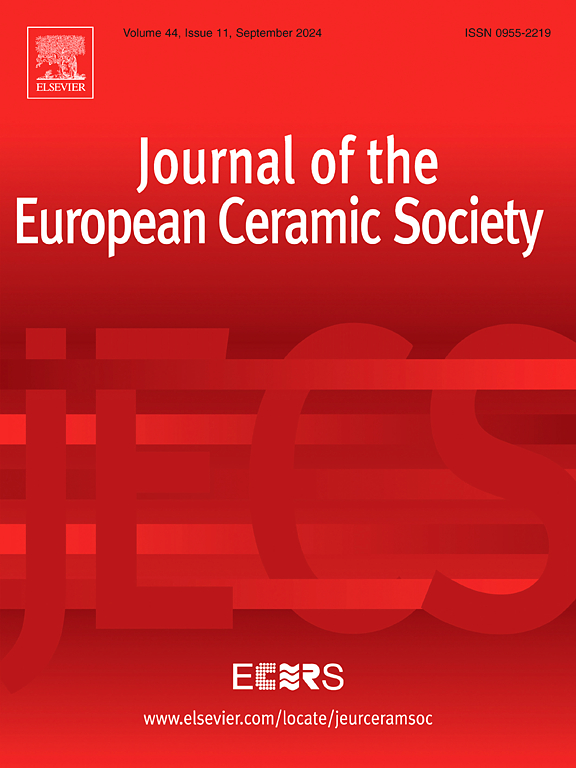扩散键合HfB2-SiC和ZrB2-SiC基复合材料的微观结构和界面稳定性
IF 5.8
2区 材料科学
Q1 MATERIALS SCIENCE, CERAMICS
Journal of The European Ceramic Society
Pub Date : 2025-04-29
DOI:10.1016/j.jeurceramsoc.2025.117489
引用次数: 0
摘要
制造复杂形状的超高温碳化物有时需要连接不同的材料。本文将ZrB2-20vol%SiC (ZS)和HfB2-20vol% SiC (HS)两种不同的复合材料(1800℃,40 MPa)与相似的复合材料ZS-ZS进行了比较。ZS-ZS接头具有均匀的硬度(~ 20 GPa)和杨氏模量(~ 366 GPa)的无缝界面。对于ZS-HS, Hf和Zr之间的扩散和反应性与(Zr, Hf)B2固溶体形成了界面,因此,HS侧的界面硬度和杨氏模量降低了(约17 %,约3 %),但与ZS侧相似。在压缩应力下,两个节理均表现出界面稳定性和相当的抗折和抗剪强度,即(ZS-HS为~ 259 MPa, ~ 87 MPa, ZS-ZS为~ 296 MPa, ~ 113 MPa)。虽然在1400℃,60 min氧化时,接头具有良好的热稳定性,但具有均匀力学性能和良好结构和热稳定性的ZS-ZS接头更有希望用于复杂形状的应用。本文章由计算机程序翻译,如有差异,请以英文原文为准。
Microstructure and interfacial stability of diffusion bonded HfB2-SiC and ZrB2-SiC based composites
Manufacturing of complex-shaped UHTCs occasionally requires joining of dissimilar materials. Herein diffusion bonded (1800 °C and 40 MPa) two dissimilar composites, ZrB2-20vol%SiC (ZS) and HfB2-20vol% SiC (HS), are compared with similar ones i.e., ZS-ZS. The ZS-ZS joints exhibit a seamless interface with uniform hardness (∼20 GPa) and Young’s Modulus (∼366 GPa). For ZS-HS, diffusion and reactivity between Hf and Zr created an interface with (Zr, Hf)B2 solid solution, thus, decreasing interfacial hardness and Young’s modulus (by ∼17 %, ∼3 %) from HS sides, but were similar to that of ZS side. Under compressive stresses, both joints exhibited interfacial stability and comparable bending and shear strength, i.e., (∼259 MPa, ∼87 MPa for ZS-HS, and ∼296 MPa, ∼113 MPa for ZS-ZS). Though good thermal stability of joints is observed when oxidized at 1400 °C, 60 min, ZS-ZS joints with uniform mechanical properties and good structural and thermal stability are more promising for complex shape applications.
求助全文
通过发布文献求助,成功后即可免费获取论文全文。
去求助
来源期刊

Journal of The European Ceramic Society
工程技术-材料科学:硅酸盐
CiteScore
10.70
自引率
12.30%
发文量
863
审稿时长
35 days
期刊介绍:
The Journal of the European Ceramic Society publishes the results of original research and reviews relating to ceramic materials. Papers of either an experimental or theoretical character will be welcomed on a fully international basis. The emphasis is on novel generic science concerning the relationships between processing, microstructure and properties of polycrystalline ceramics consolidated at high temperature. Papers may relate to any of the conventional categories of ceramic: structural, functional, traditional or composite. The central objective is to sustain a high standard of research quality by means of appropriate reviewing procedures.
 求助内容:
求助内容: 应助结果提醒方式:
应助结果提醒方式:


